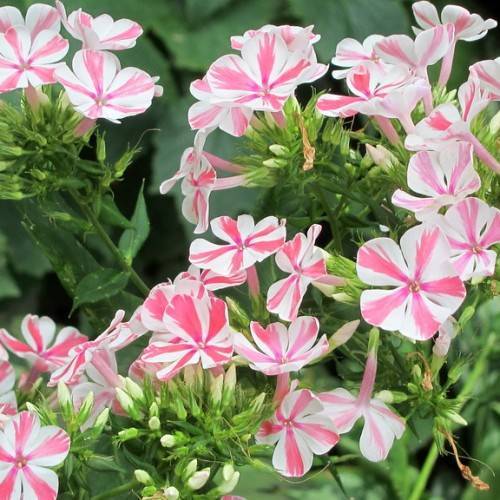
garden phlox
Phlox paniculata 'Peppermint Twist'
Also Known As - border phlox,common phlox,common phloxCycle:
Herbaceous Perennial
Watering:
Average
Hardiness Zone:
4 - 8
Flowers:
Flowers In Summer
Sun:
Full sun, Part sun/part shade
Soil:
Rocky , gravelly , dry, Well-drained
Fruits:
Fruits In Autumn Ready In Fall
Leaf:
Yes
Growth Rate:
High
Maintenance:
Moderate
Care Level:
Medium
watering
Water garden phlox (Phlox paniculata 'Peppermint Twist') regularly to keep the soil moist but not waterlogged. Water it about 1-2 inches per week, and more often if the weather is particularly hot or dry. Make sure that the phlox is receiving an even amount of water throughout the summer, stopping in late fall and winter when the plant goes dormant.
sunlight
Garden phlox (Phlox paniculata 'Peppermint Twist') prefers full sun to part shade, meaning it requires at least 6 hours of direct sunlight per day. However, it is important to note that this plant species does not enjoy intense heat and can suffer from sunburn if placed in too much full, direct sun during the hottest part of the day between 10 a.m. and 4 p.m. For this reason, it is best to plant Garden phlox in a location that receives morning sun and some afternoon shade.
pruning
Garden phlox (Phlox paniculata 'Peppermint Twist') should be pruned lightly each year in the late winter or early spring. Pruning should be done with a pair of clean, sharp pruners or shears. Remove damaged, diseased, or dead stems with a 45° angle cut about ¼ inch above a healthy bud or branch. Prune each stem back to only 3 to 4 buds for a fuller, healthier plant. Prune away any young stems that appear to be sprouting inside the plant as they will not flower. Additionally, if a plant is beginning to look historically, you can prune back to a thickness that is 1-third of the original size, and the plant should recover and bloom in the following season.
